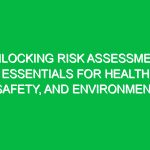Introduction
In the fast-paced world of Health, Safety, and Environment (HSE), fatigue management has emerged as a critical component of Workplace Safety and efficiency. Fatigue, often an overlooked issue, can significantly impair judgment, slow reaction times, and increase the likelihood of accidents. This article aims to explore the intricate relationship between fatigue management and HSE success, providing insights into effective strategies, regulatory considerations, and real-world implications.
Understanding Fatigue Management in the HSE Context
Fatigue management refers to the systematic approach to recognizing, assessing, and mitigating the Effects of fatigue in the workplace. In the HSE domain, this involves understanding how fatigue affects worker performance, safety, and overall well-being. Fatigue can stem from various factors, including long working hours, inadequate rest, high-stress environments, and even non-work-related issues such as family responsibilities or sleep disorders.
The importance of fatigue management cannot be overstated. According to the National Safety Council, fatigue contributes to approximately 13% of all workplace injuries. By implementing robust fatigue management strategies, organizations can not only enhance worker Safety but also boost productivity and ensure compliance with regulatory Standards.
Key Components of Fatigue Management
Fatigue management encompasses several key components, each playing a vital role in promoting a safe and productive work environment:
- Monitoring and Assessment: Regularly assessing employee fatigue levels through surveys or wearables can provide invaluable data. This information helps identify patterns and potential risks associated with fatigue.
- Rest and Recovery: Ensuring that employees have adequate time for rest and recovery is essential. Organizations should promote policies that allow for breaks, shift rotations, and sufficient off-duty hours.
- Education and Training: Providing training on the signs and effects of fatigue empowers employees to take proactive measures. This includes recognizing personal fatigue symptoms and understanding the importance of rest.
- Workplace Design: Optimizing the physical work environment can mitigate fatigue. This might involve improving lighting, reducing noise, and ensuring ergonomic workstations.
- Policies and Procedures: Establishing clear policies regarding work hours, mandatory breaks, and reporting fatigue can create a culture of Safety and awareness.
Benefits of Effective Fatigue Management
Implementing effective fatigue management practices yields numerous Benefits for organizations:
- Enhanced Safety: By reducing the risk of accidents caused by fatigue, organizations protect their employees and lower liability risks.
- Increased Productivity: Well-rested employees are more focused and efficient, leading to higher overall productivity levels.
- Improved Employee Morale: When organizations prioritize worker well-being, morale improves, fostering a positive workplace culture.
- Regulatory Compliance: Adhering to fatigue management Regulations helps organizations avoid fines and legal repercussions.
Potential Hazards and Risks Related to Fatigue Management
Fatigue poses various Hazards and risks, particularly in high-stakes environments such as construction, healthcare, and transportation. In these sectors, the consequences of fatigue can be dire. For example, a construction worker operating heavy machinery may misjudge a critical maneuver due to fatigue, leading to severe accidents. Similarly, healthcare professionals experiencing fatigue may overlook important patient care details, resulting in adverse health outcomes.
Organizations must recognize the specific risks associated with their industry and implement tailored fatigue management strategies. This could involve conducting risk assessments, engaging employees in discussions about fatigue, and developing targeted solutions to address identified hazards.
Real-Life Examples of Fatigue Management in Action
To illustrate the practical application of fatigue management, consider the case of a large transportation company that faced numerous accidents attributed to driver fatigue. In response, the company implemented a comprehensive fatigue management program that included:
- Real-time monitoring of driver hours and fatigue levels through advanced telematics.
- Mandatory rest periods and enforced regulations to prevent excessive hours.
- Training sessions for drivers on recognizing fatigue and employing strategies to combat it.
As a result of these measures, the company saw a significant reduction in fatigue-related incidents, leading to a safer work environment and improved employee satisfaction.
Regulations and Standards Governing Fatigue Management
Various regulations and standards exist to guide organizations in implementing effective fatigue management practices. In the United States, the Occupational Safety and Health Administration (OSHA) emphasizes the importance of addressing fatigue as a component of Workplace Safety. osha‘s guidelines encourage employers to adopt measures that minimize worker fatigue and promote health and safety.
Similarly, the National Institute for Occupational Safety and Health (NIOSH) provides resources and recommendations for organizations to assess and manage fatigue effectively. By aligning with these regulations, organizations not only enhance their safety culture but also mitigate the risk of legal repercussions.
Best Practices for Implementing Fatigue Management
To successfully implement fatigue management strategies, organizations should consider the following Best Practices:
- Conduct Regular Fatigue Risk Assessments: Identify high-risk tasks and roles and assess how fatigue may impact performance.
- Foster a Culture of Openness: Encourage employees to report fatigue without fear of reprimand. This creates a supportive environment for discussing fatigue-related issues.
- Utilize Technology: Leverage wearables and apps that help monitor fatigue levels and promote healthy sleep patterns.
- Engage Employees: Involve employees in the development of fatigue management policies, ensuring their insights and experiences are considered.
- Regularly Review Policies: Continually assess and adjust fatigue management strategies based on feedback and changing work conditions.
Conclusion
Fatigue management is not merely a best practice; it is an essential element of Health, Safety, and Environment success. By acknowledging the impact of fatigue on worker performance and safety, organizations can take proactive steps to manage it effectively. Implementing fatigue management strategies not only protects employees but also enhances productivity and ensures compliance with regulations.
In a world where every moment counts, organizations must prioritize fatigue management as part of their commitment to fostering a safe and healthy work environment. As we move forward, let us continue to advocate for measures that empower workers, safeguard their well-being, and contribute to a culture of success in HSE.


